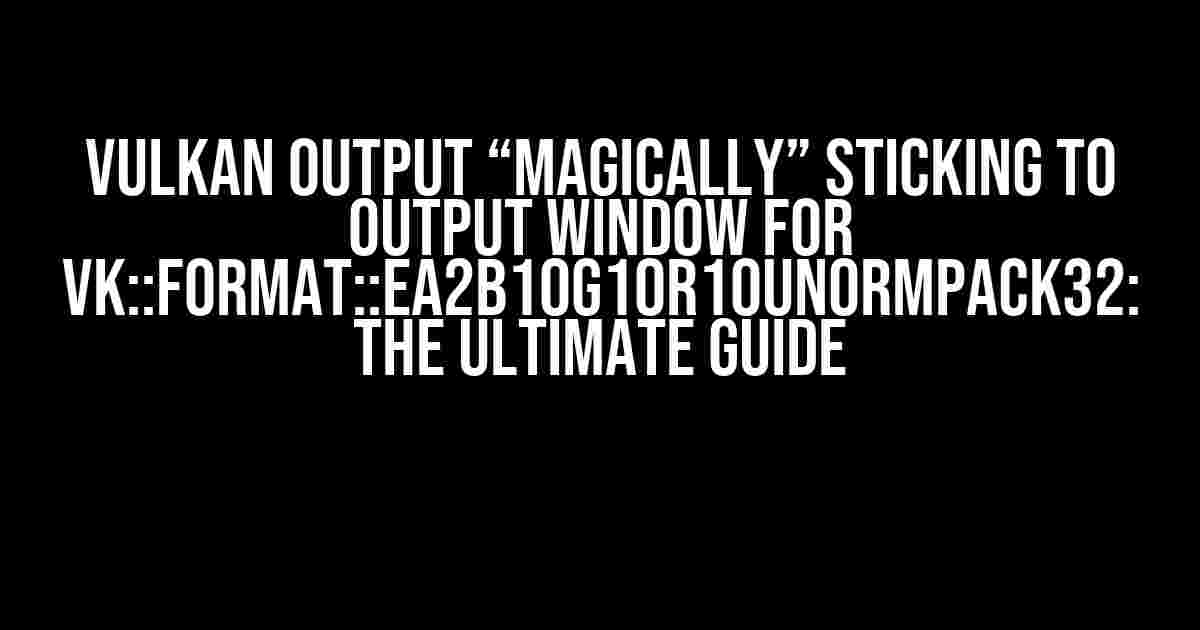Are you tired of dealing with frustrating output issues in Vulkan, where your beautifully crafted graphics just refuse to stick to the output window? Well, worry no more! In this comprehensive guide, we’ll dive into the mystical world of Vulkan and demystify the magic behind getting your output to stick to the output window for the infamous vk::Format::eA2B10G10R10UnormPack32 format.
Understanding the Problem
Before we dive into the solution, let’s take a step back and understand the problem. When using Vulkan, you might have noticed that your output window remains blank, despite your best efforts to render magnificent graphics. This is often due to the Vulkan output not being properly configured to stick to the output window.
The vk::Format::eA2B10G10R10UnormPack32 format is a particularly tricky one, as it requires specific configuration to work correctly. But fear not, dear reader, for we’re about to embark on a journey to tame this beast and get your output sticking to the output window like glue!
Step 1: Creating a Vulkan Instance
The first step in getting your Vulkan output to stick to the output window is to create a Vulkan instance. This might seem obvious, but trust us, it’s essential to get this right!
VkApplicationInfo appInfo = {};
appInfo.sType = VK_STRUCTURE_TYPE_APPLICATION_INFO;
appInfo.pApplicationName = "My Vulkan App";
appInfo.applicationVersion = VK_MAKE_VERSION(1, 0, 0);
appInfo.pEngineName = "My Engine";
appInfo.engineVersion = VK_MAKE_VERSION(1, 0, 0);
appInfo.apiVersion = VK_API_VERSION_1_2;
VkInstanceCreateInfo instanceCreateInfo = {};
instanceCreateInfo.sType = VK_STRUCTURE_TYPE_INSTANCE_CREATE_INFO;
instanceCreateInfo.pApplicationInfo = &appInfo;
VkInstance instance;
vkCreateInstance(&instanceCreateInfo, nullptr, &instance);
Step 2: Creating a Vulkan Surface
Now that we have a Vulkan instance, it’s time to create a Vulkan surface. This surface will serve as the canvas for our graphics, and we need to configure it to work with our output window.
VkSurfaceKHR surface;
VkWin32SurfaceCreateInfoKHR surfaceCreateInfo = {};
surfaceCreateInfo.sType = VK_STRUCTURE_TYPE_WIN32_SURFACE_CREATE_INFO_KHR;
surfaceCreateInfo.hinstance = GetModuleHandle(NULL);
surfaceCreateInfo.hwnd = hwnd;
vkCreateWin32SurfaceKHR(instance, &surfaceCreateInfo, nullptr, &surface);
Step 3: Choosing the Right Format
This is where things get interesting! The vk::Format::eA2B10G10R10UnormPack32 format is a packed format, which means we need to configure our swapchain to work with it correctly.
VkSurfaceFormatKHR surfaceFormat;
vkGetPhysicalDeviceSurfaceFormatsKHR(physicalDevice, surface, &formatCount, &surfaceFormat);
VkFormat format = VK_FORMAT_A2B10G10R10_UNORM_PACK32;
Step 4: Creating a Swapchain
A swapchain is a crucial component in Vulkan, as it allows us to present our graphics to the output window. We need to configure our swapchain to work with our chosen format and surface.
VkSwapchainCreateInfoKHR swapchainCreateInfo = {};
swapchainCreateInfo.sType = VK_STRUCTURE_TYPE_SWAPCHAIN_CREATE_INFO_KHR;
swapchainCreateInfo.surface = surface;
swapchainCreateInfo.minImageCount = 2;
swapchainCreateInfo.imageFormat = format;
swapchainCreateInfo.imageColorSpace = VK_COLOR_SPACE_SRGB_NON_LINEAR_KHR;
swapchainCreateInfo.imageExtent = {width, height};
swapchainCreateInfo.imageArrayLayers = 1;
swapchainCreateInfo.imageUsage = VK_IMAGE_USAGE_COLOR_ATTACHMENT_BIT;
swapchainCreateInfo.queueFamilyIndexCount = 1;
swapchainCreateInfo.pQueueFamilyIndices = &queueFamilyIndex;
VkSwapchainKHR swapchain;
vkCreateSwapchainKHR(device, &swapchainCreateInfo, nullptr, &swapchain);
Step 5: Creating an Image View
An image view is a Vulkan object that allows us to access our swapchain images. We need to create an image view that matches our chosen format and surface.
VkImageViewCreateInfo imageViewCreateInfo = {};
imageViewCreateInfo.sType = VK_STRUCTURE_TYPE_IMAGE_VIEW_CREATE_INFO;
imageViewCreateInfo.image = swapchainImages[0];
imageViewCreateInfo.viewType = VK_IMAGE_VIEW_TYPE_2D;
imageViewCreateInfo.format = format;
imageViewCreateInfo.components = {
VK_COMPONENT_SWIZZLE_R,
VK_COMPONENT_SWIZZLE_G,
VK_COMPONENT_SWIZZLE_B,
VK_COMPONENT_SWIZZLE_A
};
imageViewCreateInfo.subresourceRange = {VK_IMAGE_ASPECT_COLOR_BIT, 0, 1, 0, 1};
VkImageView imageView;
vkCreateImageView(device, &imageViewCreateInfo, nullptr, &imageView);
Putting it All Together
Now that we’ve configured our Vulkan instance, surface, format, swapchain, and image view, it’s time to put it all together and render our graphics!
VkCommandBufferBeginInfo commandBufferBeginInfo = {};
commandBufferBeginInfo.sType = VK_STRUCTURE_TYPE_COMMAND_BUFFER_BEGIN_INFO;
vkBeginCommandBuffer(commandBuffer, &commandBufferBeginInfo);
VkRenderPassBeginInfo renderPassBeginInfo = {};
renderPassBeginInfo.sType = VK_STRUCTURE_TYPE_RENDER_PASS_BEGIN_INFO;
renderPassBeginInfo.renderPass = renderPass;
renderPassBeginInfo.framebuffer = framebuffer;
renderPassBeginInfo.renderArea = { {0, 0}, {width, height} };
renderPassBeginInfo.clearValueCount = 1;
renderPassBeginInfo.pClearValues = &clearValue;
vkCmdBeginRenderPass(commandBuffer, &renderPassBeginInfo, VK_SUBPASS_CONTENTS_INLINE);
vkCmdDraw(commandBuffer, vertexCount, 1, 0, 0);
vkCmdEndRenderPass(commandBuffer);
vkEndCommandBuffer(commandBuffer);
Tips and Tricks
Here are some additional tips and tricks to help you get the most out of your Vulkan output:
- Make sure to handle VK_ERROR_OUT_OF_DATE_KHR errors when presenting the swapchain.
- Use VK_IMAGE_LAYOUT_PRESENT_SRC_KHR when transitioning the image layout for presentation.
- Verify that your output window is properly configured to work with Vulkan.
- Experiment with different formats and surface configurations to find the best fit for your application.
Conclusion
And there you have it, folks! With these steps and a dash of creativity, you should be able to get your Vulkan output sticking to the output window like magic. Remember to stay patient, persistent, and curious, and you’ll be rendering breathtaking graphics in no time.
Don’t forget to experiment and try out new things – the world of Vulkan is full of mysteries waiting to be uncovered. Good luck, and happy coding!
| Format | Description |
|---|---|
| VK_FORMAT_A2B10G10R10_UNORM_PACK32 | A 32-bit packed format with 10-bit unsigned normalized values for red, green, and blue components, and a 2-bit unsigned normalized value for the alpha component. |
Frequently Asked Question
Get ready to unravel the mystery of Vulkan output “magically” sticking to the output window for vk::Format::eA2B10G10R10UnormPack32! Here are the answers to your burning questions:
Why does my Vulkan output stick to the output window when using vk::Format::eA2B10G10R10UnormPack32?
This is due to the way Vulkan handles framebuffer attachments. The vk::Format::eA2B10G10R10UnormPack32 format is a packed format, where the entire pixel is represented by a single 32-bit word. When you create a swapchain with this format, Vulkan will automatically create a compatible framebuffer attachment, which is what’s causing the output to “stick” to the window.
How can I avoid this “sticking” issue with vk::Format::eA2B10G10R10UnormPack32?
One way to avoid this issue is to use a different format for your swapchain, such as vk::Format::eB8G8R8A8Unorm. Alternatively, you can create a separate render pass with a compatible attachment format, and then transition the image layout to the desired format after rendering.
What are the benefits of using vk::Format::eA2B10G10R10UnormPack32?
This format offers better compression and reduced memory bandwidth, making it a great choice for applications that require high-performance rendering. Additionally, it’s a widely supported format, making it a good option for cross-platform development.
Can I use vk::Format::eA2B10G10R10UnormPack32 with other Vulkan features, like multisampling?
Yes, you can use vk::Format::eA2B10G10R10UnormPack32 with multisampling, but you’ll need to ensure that your multisample attachment has a compatible format. You can create a multisample attachment with a format like vk::Format::eA2B10G10R10UnormPack32, and then resolve the multisample image to a single-sample image with a compatible format.
Are there any known issues or limitations with vk::Format::eA2B10G10R10UnormPack32?
Yes, one known limitation is that this format may not be supported by all Vulkan implementations, particularly on mobile devices. Additionally, some graphics cards may have issues with texture sampling or blending when using this format. Be sure to test your application thoroughly to ensure compatibility.





